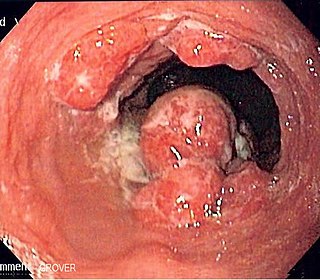Related Research Articles

Otorhinolaryngology is a surgical subspeciality within medicine that deals with the surgical and medical management of conditions of the head and neck. Doctors who specialize in this area are called otorhinolaryngologists, otolaryngologists, head and neck surgeons, or ENT surgeons or physicians. Patients seek treatment from an otorhinolaryngologist for diseases of the ear, nose, throat, base of the skull, head, and neck. These commonly include functional diseases that affect the senses and activities of eating, drinking, speaking, breathing, swallowing, and hearing. In addition, ENT surgery encompasses the surgical management of cancers and benign tumors and reconstruction of the head and neck as well as plastic surgery of the face and neck.

Skin cancers are cancers that arise from the skin. They are due to the development of abnormal cells that have the ability to invade or spread to other parts of the body. There are three main types of skin cancers: basal-cell skin cancer (BCC), squamous-cell skin cancer (SCC) and melanoma. The first two, along with a number of less common skin cancers, are known as nonmelanoma skin cancer (NMSC). Basal-cell cancer grows slowly and can damage the tissue around it but is unlikely to spread to distant areas or result in death. It often appears as a painless raised area of skin that may be shiny with small blood vessels running over it or may present as a raised area with an ulcer. Squamous-cell skin cancer is more likely to spread. It usually presents as a hard lump with a scaly top but may also form an ulcer. Melanomas are the most aggressive. Signs include a mole that has changed in size, shape, color, has irregular edges, has more than one color, is itchy or bleeds.

Esophageal cancer is cancer arising from the esophagus—the food pipe that runs between the throat and the stomach. Symptoms often include difficulty in swallowing and weight loss. Other symptoms may include pain when swallowing, a hoarse voice, enlarged lymph nodes ("glands") around the collarbone, a dry cough, and possibly coughing up or vomiting blood.

Endometrial cancer is a cancer that arises from the endometrium. It is the result of the abnormal growth of cells that have the ability to invade or spread to other parts of the body. The first sign is most often vaginal bleeding not associated with a menstrual period. Other symptoms include pain with urination, pain during sexual intercourse, or pelvic pain. Endometrial cancer occurs most commonly after menopause.

Oral cancer, also known as mouth cancer, is cancer of the lining of the lips, mouth, or upper throat. In the mouth, it most commonly starts as a painless white patch, that thickens, develops red patches, an ulcer, and continues to grow. When on the lips, it commonly looks like a persistent crusting ulcer that does not heal, and slowly grows. Other symptoms may include difficult or painful swallowing, new lumps or bumps in the neck, a swelling in the mouth, or a feeling of numbness in the mouth or lips.

Ovarian cancer is a cancerous tumor of an ovary. It may originate from the ovary itself or more commonly from communicating nearby structures such as fallopian tubes or the inner lining of the abdomen. It results in abnormal cells that have the ability to invade or spread to other parts of the body. When this process begins, there may be no or only vague symptoms. Symptoms become more noticeable as the cancer progresses. These symptoms may include bloating, pelvic pain, abdominal swelling, constipation, and loss of appetite, among others. Common areas to which the cancer may spread include the lining of the abdomen, lymph nodes, lungs, and liver.

Anal cancer is a cancer which arises from the anus, the distal opening of the gastrointestinal tract. Symptoms may include bleeding from the anus or a lump near the anus. Other symptoms may include pain, itchiness, or discharge from the anus. A change in bowel movements may also occur.

Head and neck cancer develops from tissues in the lip and oral cavity (mouth), larynx (throat), salivary glands, nose, sinuses or the skin of the face. The most common types of head and neck cancers occur in the lip, mouth, and larynx. Symptoms predominantly include a sore that does not heal or a change in the voice. Some may experience a sore throat that does not go away. In those with advanced disease, there may be unusual bleeding, facial pain, numbness or swelling, and visible lumps on the outside of the neck or oral cavity. Given the location of these cancers, trouble breathing may also be present.

The neck dissection is a surgical procedure for control of neck lymph node metastasis from squamous cell carcinoma (SCC) of the head and neck. The aim of the procedure is to remove lymph nodes from one side of the neck into which cancer cells may have migrated. Metastasis of squamous cell carcinoma into the lymph nodes of the neck reduce survival and is the most important factor in the spread of the disease. The metastases may originate from SCC of the upper aerodigestive tract, including the oral cavity, tongue, nasopharynx, oropharynx, hypopharynx, and larynx, as well as the thyroid, parotid and posterior scalp.

Verrucous carcinoma (VC) is an uncommon variant of squamous cell carcinoma. This form of cancer is often seen in those who chew tobacco or use snuff orally, so much so that it is sometimes referred to as "Snuff dipper's cancer".
The Danish Head and Neck Cancer (DAHANCA) group was established in 1976 as a working group by the Danish Society for Head and Neck Oncology with the primary aim to develop national guidelines for the treatment of head and neck cancer in Denmark.

Esthesioneuroblastoma is a rare cancer of the nasal cavity. Arising from the upper nasal tract, esthesioneuroblastoma is believed to originate from sensory neuroepithelial cells, also known as neuroectodermal olfactory cells.
Eric M. Genden, MD, MHCA, FACS is a United States head and neck cancer surgeon at the Icahn School of Medicine at Mount Sinai and Mount Sinai Health System in New York City. where he serves as the Isidore Friesner Professor and Chairman of Otolaryngology–Head and Neck Surgery and Professor of Neurosurgery and Immunology. According to his biography at Mount Sinai, Genden's professional titles also include Senior Associate Dean for Clinical Affairs, He is Executive Vice President of Ambulatory Surgery, and Director of the Head and Neck Institute at the Mount Sinai Health System.

Oropharyngeal cancer (OPC), also known as oropharyngeal squamous cell carcinoma (OPSCC) and tonsil cancer, is a disease in which abnormal cells with the potential to both grow locally and spread to other parts of the body are found in the oral cavity, in the tissue of the part of the throat (oropharynx) that includes the base of the tongue, the tonsils, the soft palate, and the walls of the pharynx.

Human papillomavirus-positive oropharyngeal cancer, is a cancer of the throat caused by the human papillomavirus type 16 virus (HPV16). In the past, cancer of the oropharynx (throat) was associated with the use of alcohol or tobacco or both, but the majority of cases are now associated with the HPV virus, acquired by having oral contact with the genitals of a person who has a genital HPV infection. Risk factors include having a large number of sexual partners, a history of oral-genital sex or anal–oral sex, having a female partner with a history of either an abnormal Pap smear or cervical dysplasia, having chronic periodontitis, and, among men, younger age at first intercourse and a history of genital warts. HPV-positive OPC is considered a separate disease from HPV-negative oropharyngeal cancer.

Nanobiotix is a biotechnology company that uses nanomedicine to develop new radiotherapy techniques for cancer patients. The company is headquartered in Paris, with additional corporate offices in New York and Massachusetts.

Buparlisib is an experimental anti-cancer medication. It is a small molecule orally-available pan-class I phosphoinositide 3-kinase (PI3K) inhibitor. Buparlisib was under investigation as a treatment for advanced breast cancer but was abandoned due to negative results. It is still under investigation as a potential treatment for head and neck squamous cell carcinoma (HNSCC).
Carcinoma of the tonsil is a type of squamous cell carcinoma. The tonsil is the most common site of squamous cell carcinoma in the oropharynx. It comprises 23.1% of all malignancies of the oropharynx. The tumors frequently present at advanced stages, and around 70% of patients present with metastasis to the cervical lymph nodes. . The most reported complaints include sore throat, otalgia or dysphagia. Some patients may complain of feeling the presence of a lump in the throat. Approximately 20% patients present with a node in the neck as the only symptom.

Nabil F. Saba is an American oncologist. He is currently Professor and Vice-chair of Hematology and Medical Oncology, and Professor of Otolaryngology at the Winship Cancer Institute at the Emory University School of Medicine in Atlanta, Georgia. He is a specialist in the field of head and neck oncology. Saba has authored more than 200 peer-reviewed articles. He is the inaugural Lynne and Howard Halpern Chair in Head and Neck Cancer Research.
The Oral Cancer Foundation, sometimes abbreviated to OCF, is an American, IRS registered, 501(c)3 non-profit organization, which focuses on oral and oropharyngeal cancer related issues and public awareness of the disease.
References
- ↑ "Celebrities as lifesavers". Usatoday.Com. 2007-01-07. Retrieved 2019-06-23.
- ↑ "University of Michigan Health System" group="Comprehensive Cancer Center"> "Head and Neck Cancer Awareness" . Retrieved 2014-03-03.
- ↑ Majchrzak, E; Szybiak, B; Wegner, A; Pienkowski, P; Pazdrowski, J; Luczewski, L; Sowka, M; Golusinski, P; Malicki, J; Golusinski, W (2014). "Oral cavity and oropharyngeal squamous cell carcinoma in young adults: a review of the literature". Radiol Oncol. 48 (1): 1–10. doi:10.2478/raon-2013-0057. PMC 3908841 . PMID 24587773.
- ↑ "Department of Otolaryngology-Head and Neck Surgery - University of Virginia School of Medicine site". Department of Otolaryngology-Head and Neck Surgery.
- ↑ Head and Neck Cancer Alliance. 2014. http://www.headandneck.org/site/c.8hKNI0MEImI4E/b.8987745/k.18F1/2014_Awareness_Events.htm Archived 2014-03-04 at archive.today
- ↑ "Indiana University"."Department of Otolaryngology–Head and Neck Surgery"> "Humanitarian Efforts". www.medicine.iu.edu. Archived from the original on 25 April 2014. Retrieved 4 March 2014.
- ↑ "Head and Neck Cancer Alliance -- Feist-Weiller Cancer Center -- Shreveport, LA". feistweiller.org.
- 1 2 Shuman, Andrew G.; McKiernan, Janet T.; Thomas, Dorothy; Patel, Prateek; Palmer, Frank L.; Shaffer, Brian T.; Shah, Jatin P.; Patel, Snehal G.; Boyle, Jay O. (2013). "Outcomes of a head and neck cancer screening clinic". Oral Oncology. 49 (12): 1136–1140. doi:10.1016/j.oraloncology.2013.09.007. PMID 24084407.
- ↑ "FAQs - Head and Neck Cancer Alliance". Archived from the original on 2014-05-31. Retrieved 2014-05-30.
- ↑ "Archived copy". iTunes . Archived from the original on 2016-03-06. Retrieved 2014-05-30.
{{cite web}}: CS1 maint: archived copy as title (link)